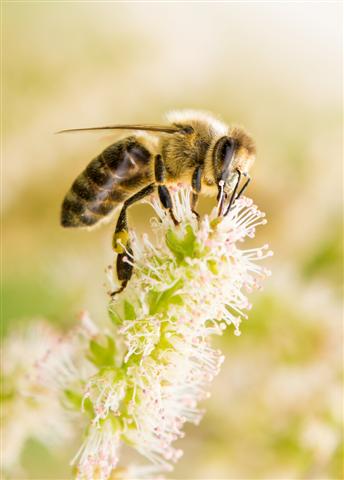by Dr. Craig A. Maxwell
Since 2006, a disturbing new phenomenon called colony collapse disorder has ruined the livelihood of beekeepers and created a growing uncertainty about the future of food. In the United States alone, a full one-third of our crops depend on bee pollination in order to survive. If you’ve decided to plant some bee-friendly plants in the hopes of preventing bee die-offs, you may be making the problem worse.
A Sobering Look at Massive Bee Die-Offs
- Earlier this year, hundreds of beekeepers across the United States reported losing anywhere from 40-90 percent of their hives.
- California orchards suffered huge financial losses when they could not find enough bees to pollinate their almond trees.
- A new pesticide called “Safari” was banned from use in Oregon after 50,000 bees found dead in a Target parking lot.
- Dave Schuit, beekeeper in Ontario, Canada, lost his entire colony (37 million bees) because a nearby farm planted corn sprayed with neonicotinoids (neuro-active insecticides).
- The Smith Family Honey Company in Florida lost $150,000 worth of bees as a result of pesticide contamination from a nearby farm.
What is Colony Collapse Disorder? In colony collapse disorder, worker bees leave the hive to pollinate but never make it back. They are often found hundreds of miles away, disoriented or dead. This phenomenon is not limited to the United States and Canada. Reports of devastating colony collapse have come in from Belgium, France, the Netherlands, Greece, Italy, Portugal, Spain, Switzerland and Germany.
Neonicotinoids and Bee Die-Off
According to published reports, 90% of the corn grown in the United States (specifically the mid-west) is coated with a type of bee-killing pesticide known as a neonicotinoid. Neonicotinoids are neuro-active insecticides that are chemically similar to nicotine. These new pesticides were released by Bayer in the 1990s in response to the concern that organophosphate and carbamate pesticides were too toxic to animals and humans. Unfortunately, neonicotinoids are highly-toxic to bees and have been linked to colony collapse disorder and massive bee die-off. Bees exposed to this pesticide appear incapacitated and stunned as the chemical slowly decimates their nervous system. Studies have noted that massive bee die-off may increase in areas of high humidity; presumably because the pesticides more easily stick to the body and absorb into the skin.
What Your Supermarket Would Look Like in a World without Bees
Bees are as fundamental to crop growth as water and sunlight. In a world without bees, over 50% of the produce section in your grocery store would be gone. No more apples, plums, peaches, pears, strawberries, onions, avocados, or walnuts. Say goodbye to coffee, Brazil nuts, peppers, raspberries, blackberries, tangerines, coconut, hazelnut, figs, and flax. And that is just a very small portion of what you can expect to lose. Estimates state that in a world without bees, only 500 million people could expect to live on what’s left. What would that mean for everyone else?
Could Your Garden Plants be Killing Bees?
In the past couple of years, there has been more focus on what the individual can do to prevent bee die-off and colony collapse disorder. In response to this growing epidemic, home gardeners have been encouraged to grow “bee-friendly” plants. This is a good idea. However, the plants you have in your garden right now could be encouraging, not preventing bee die-off. Leading home improvement and gardening centers such as Lowe’s and Home Depot are taking advantage of the blooming interest in saving the bees. What they don’t tell you about their plants is that nearly all of them contain pesticides that are harmful to the bees and butterflies that visit your garden. European companies have already removed these dangerous plants from their shelves but the United States has failed to catch up. This is where you come in.
What You Can Do to Offset Massive Bee Die-Off
- Grow from Seed
Instead of buying flowers that have already been grown and sprayed with bee-killing pesticide, plant from seed instead. Purchase organic, non-GMO seeds, regular garden dirt (without added pesticides), and start your own compost heap. It may take a bit longer to get your lawn looking beautiful but it will be well worth it for the health of the bees.
- Plant Vegetables
Instead of planting flowers, plant vegetables from seed. Carrots, lettuce, beans, spinach, cucumbers, tomatoes, peppers, radishes, basil, and squash are all easy-to-grow plants for the novice gardener. Buy organic, non-GMO seeds, regular garden dirt (without added pesticides), and start your own compost heap. Also, let your vegetable garden “bolt” (go to seed) after harvesting. This allows bees to seed plants and stock up on food before the colder months.
- Provide a Bee Habitat
Bees need a secure place to live. You can provide them with one by setting out a few bee blocks or digging up a few mounds of loose earth next to a water source.
- Buy Local Honey
There has never been a more important time to support your local farmers. Buying local honey gives back to the farmers who are already struggling to keep their bees and livelihood alive. While you’re at your local farmer’s market, pick up some local produce as well (until your great garden grows of course). Bee die-offs are a very real and growing problem. If you’re concerned about bee die-off, there is plenty you can do to help offset it. Try these techniques and share them with your friends. It could mean the difference between a growing, thriving planet and one in serious peril.








